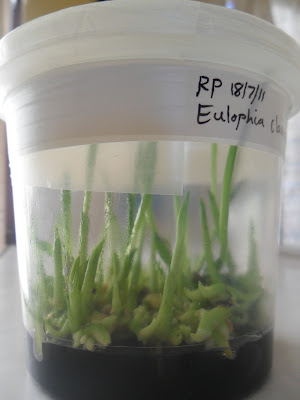Finally, after waiting nearly two months I received my Hepa filter from Germany and installed it into the new laminar flow hood. The laminar flow was built according to the specifications that I put up on the blog in a previous post. I cautiously tested the unit the other day for any contamination. I ran the hood for 30 minutes with an open plate of medium and then incubated the plate for 72 hours to check for microbiological contamination. After all was well, I started to play. I must say that it makes working with seeds and re-plates a lot less stressful. Still, I have a healthy respect for sterility :)
 |
| Laminar flow in use |
I have had marked success recently with some Dendrobium species from Thailand and some of my own seeds. My dry seed protocol is working well now, even with slightly more sensitive species. I have attached some images of germinating seeds of some of the Dendrobium species and some others below. However, I am having a few issues with Phalaenopsis protocorms. I get good germination but poor protocorm differentiation currently. I am tweaking the media to eliminate possible causes and hopefully soon, through process of elimintaion, I can report back with some better success here. So far, I have managed to raise a few P. lowii protocorms and some P. purple gems. More mother flasks of various hybrids are awaiting germination on tweaked media.
 |
| Dendrobium griffithianum |
 |
| Dendrobium hercoglossum |
 |
| Dendrobium heterocarpum |
 |
| Dendrobium lituiflorum |
 |
| Dendrobium parishii |
 |
| Dendrobium signatum |
 |
| Dendrobium wardianum |
 |
| Anacheilium cochleatum |
 |
| Dendrobium annosum |
My Eulophias are also doing very well. I seem to have tackled the proliferation problem of the protocorms with a change of media type and have since moved some seedlings of Eulophia speciosa into the greenhouse to grow on further. I have attached some images here of Casper's E. angolensis and E. clavicornis that are nearing readiness to be sent off. I have also included images of the developing seedlings of Bradley's Mystacidium capense and my Polystachya anceps.
 |
| Casper's Eulophia clavicornis |
 |
| Casper's Eulophia angolensis |
 |
| Polystachya anceps |
 |
| Bradley's Mystacidium capense |
Lastly, I have included a few images of my flowering Cyrtorchis chailuana. I have been looking forward to these flowers for a while and they are heavily scented in the evening to attract hawk moths. I have selfed a few and have two pods developing. Bradley was kind enough to give me some Angraecum eberneum pollen to use in hybridisation but none of these took unfortunately.
 |
| Cyrtorchis chailuana |

No comments:
Post a Comment